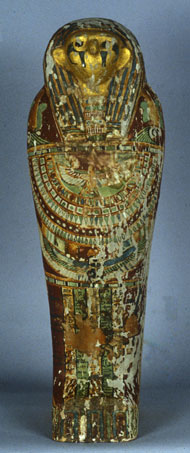
Osiris Mummy (Grain Mummy)
Egypt, ca. 332 BC - 395 AD
Linen wrappings, polychrome case
Everhart Museum Collection, 60.69
Gift of William W. Scranton
This form does not contain animal remains, but has been decorated as a
falcon to symbolize the gods Horus (in life) and Osiris (in death). Called a
"corn" or "grain" mummy, the wrappings contain emmer wheat, a popular
staple. These mummies were placed in tombs with the deceased and invoked the
gods to aid the resurrection process. Cereal grains were symbols of life and
rebirth as the dormant seed sprouted from the dead husk. |
Over the years the Museum has amassed a collection of works from around the globe. This includes works from Native American sources, pre-Columbian and south American objects, work from Africa, China, Japan, India, Indonesia, Korea and Tibet.
THE AFRICAN COLLECTION
There is a permanent exhibition space at the Museum dedicated to the African Collection. The exhibition, titled Africa in a New Light, includes art from twelve of Africa’s fifty-four nations and represents eighteen of the many hundreds of Africa’s cultural groups. Viewers can appreciate the beauty of the pieces and learn the meanings and roles of the figures, masks, jewelry, and musical instruments in everyday African life. There are power figures intended for protection, masks worn as part of full body costumes, harps and drums that – like the masks – participate in masquerades, and ceremonial blades and jewelry that reveal a person's status as well as enhancing his or her appearance. |

